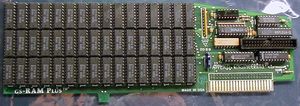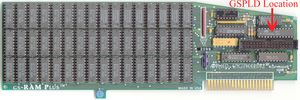GS-RAM Plus
The GS-RAM Plus is a RAM Board capable of 6 Meg on-board for the Apple IIgs computer made by Applied Engineering (aka - AE).
The DRAM used are standard 1Meg x 1bit DRAMs, and the board can be expanded 1 Meg at a time. AE's rare optional 2 MEG Piggyback Card could also be installed and expand the RAM up to a total of 8 Megs, however this was rarely if ever done due to the cost of RAM at the time. AE also claims the board is "fully DMA (direct memory access) compatible", however this can't be so since the PFI/CYA isn't being bypassed on the IIgs motherboard. Nor was any software ever written to test or take advantage of DMA-able RAM above 4 Megs.
The GS-RAM Plus board had a several revisions and required certain GAL revisions in order to work in either the ROM1 or ROM3 IIgs. No one GAL revision existed which allows the RAM board to work in both IIgs systems.
History
Henry from ReActiveMicro received a GS-RAM Plus from the Washington Apple Pi users group when they were cleaning out their Apple II connection back in 2006. Henry was in the process of studying PALs and GALs at the time and found that the GS-RAM Plus board worked in some IIgs units but not others. After a lot of research Henry discovered the revision of the GSPLD1 mattered, and is what ultimately allowed for the board's correct operation depending on the ROM revision of the IIgs the GS-RAM Plus was installed.
The PLDs however were secured and were unable to be read or copied directly. Luckily the PLDs were early GALs which could have their code extracted using a Run-Fei RF-2148USB IC programmer. The software for the programmer allows for some early PLDs with security issues to be copied regardless of the security bit being set. Henry was in luck and was able to read and duplicate all the PLDs for this board.
Different Versions of the GS-RAM Plus Board
There are two known revisions of the GS-RAM Plus board. "REV D" and "REV E". The identifier marking can be found on the small tab or "support foot" on the board in the middle of the bottom edge under the RAM sockets area. The marking is on both the face and rear of the tab. The only difference noticeable about the revisions is the date code on the PCB.
- Pics Of The GS-RAM Plus Board
-
Revision "D" board.
-
Revision "E" board and PLD marking.

